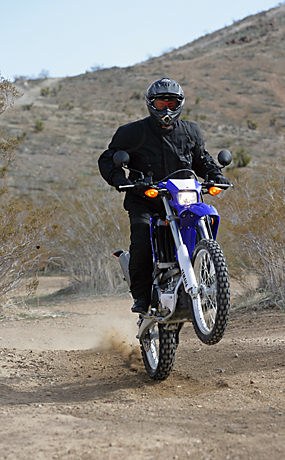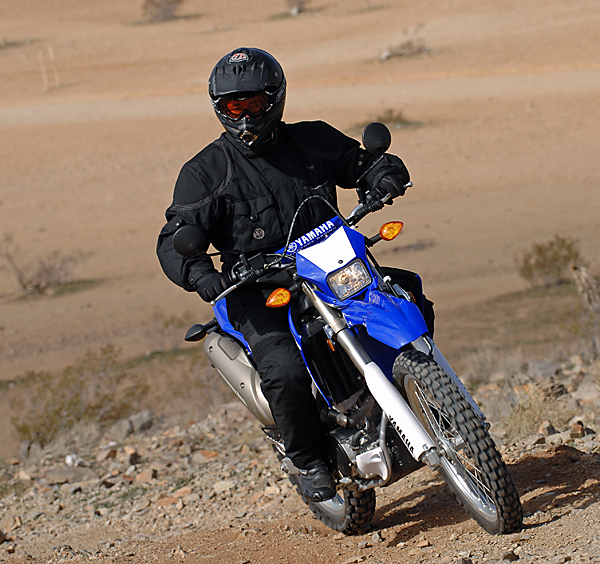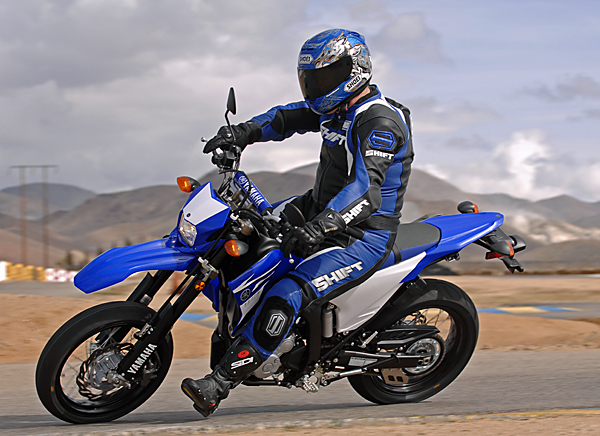

We have to admit we were a bit surprised when Yamaha announced in September of 2007 that it has invested heavily in a new engine and chassis for a dual sport and supermoto displacing 250cc. Why? This is not a category that other manufacturers have paid much attention to . . . particularly, here in the United States. Old tech motors and off-the-shelf components have been the rule here, not the exception.
In any event, I looked forward to riding both of these machines for a number of reasons. First, my real background is on dirt bikes, and the upright, dirt bike-style riding position always appeals to me. Second, lightweight, street legal singles have always proved to be lots of fun, and this modern engine/chassis combo was enticing.
We gave our readers a pretty good introduction to the technical aspects of these new 250cc singles back on September 12, 2007. Nevertheless, we thought we would go through some of the highlights here, and then get straight into the riding impressions.
At the riding intro, Yamaha started by giving us some interesting statistics. To begin with, despite the motorcycle industry as a whole showing a downturn in sales, dual purpose motorcycle sales continue to grow. Indeed, growth in this category has been nearly 100% in the last five years, far outstripping the overall industry average. Other statistics shown at the intro indicate the average dual purpose rider is 44 years old (a good percentage have pretty decent disposable income), and that a majority of riders shopping in this category favor high tech features (such as modern engine and chassis design) and express some dissatisfaction with component quality found on dual purpose bikes, in general.
Yamaha wanted these bikes to appeal to experienced riders and beginners, alike. A smooth, usable powerband was essential, as was light weight, and predictable handling.
To summarize the details we discussed in our earlier article back in September, these bikes feature an all-new 249cc four-stroke engine design that is liquid cooled, has four valves, and features fuel injection with a six speed transmission. A wet sump oiling system keeps the center of gravity low, and electric start buttons on both models keep starting simple and reliable. Borrowed from the Yamaha street bike category, an EXUP exhaust valve helps further broaden power delivery.

The new engine features titanium intake valves, and very straight intake ports. Compression is 11.8 to 1. To smooth things out, a single shaft counter-balancer is utilized to minimize vibration inherent in a single-cylinder design.
The fuel injection system features 38mm throttle bodies in a down draft configuration. Twelve hole injectors increase atomization of the fuel for more efficient combustion (more power and better mpg).
Continuing with the high tech theme, a powerful 16-bit CPU controls things while a direct ignition coil is used (stick coil) above the spark plug. The air box is large (4.1 liters) and features easy access to a cleanable, reusable air filter.
The aluminum frame clamps onto fully adjustable suspension, front and rear, just like a modern motocross bike. Available wheel travel is 10.6 inches at both ends. A simple to use ride height adjuster under the rear shock (providing .9 inches of adjustability) is a great idea and would be a useful addition to many other machines.
The two gallon gas tank should provide usable range for a small, fuel efficient single cylinder bike, although we did not have a chance to check mpg at the press intro.
If you have ridden dual sport bikes, you know that seat design is critical. Combining rider movement off-road with drone-on-the-freeway comfort is a difficult task. Yamaha stressed its efforts to design the ultimate dual purpose seat for both of these models.
The main difference between these two bikes (aside from the larger front disc found on the supermoto model) is the tire sizes. The supermoto features 17″ street tires, while the dual sport has an 18″ rear and 21″ front typical of off-road machines.

The multi-function instrument panel features a speedometer, odometer, two trip meters, fuel trip meter, clock and diagnostics. Additionally, several warning lights include low fuel, coolant temperature, engine warning, neutral, turn signals and high beam. The headlight is a single bulb H4 (60/55 watt), while the tail light is an LED unit.
We started out by riding the dual sport WR250R on the road, and ended up in the Southern California high desert for some trail riding. We even tried some fairly technical single track. The first thing we noticed about the WR250R was the engine performance. It was surprisingly strong for a single-cylinder 249cc unit.
The six-speed transmission provides essentially two overdrives (both fifth and sixth), and the little motor had no problem pulling these tall gears on the street. We were able to cruise at an indicated 80 mph with no problem whatsoever, and the bike even had a little bit left in reserve to pull beyond that speed.

The engine was also extremely smooth for a single cylinder. We found no annoying vibration at any rpm level, which is actually quite shocking for a single on the road. The bike was very stable at high speeds, and very light steering (as you might expect given the low dry weight). The comfort for straight line travel on the road was excellent. The seat is wide enough (something important for a dual purpose machine) for comfortable street use. The brakes on the WR250R were adequate for the street (although the front disc on the WR250X supermoto is phenomenal . . . more about that later).
When we went off-road, the handling that impressed us on-road translated perfectly. At over 200 lbs., I expected to bottom the fork through the sand whoops we hit at 35 or 40 miles per hour, but the suspension soaked it all up without bottoming. Very impressive for a dual purpose machine that didn’t feel too stiff on the street.

I was particularly impressed by the Bridgestone dual purpose tires in the slick California desert conditions we experienced. The Bridgestone TW301/TW302 tires seem to provide an excellent compromise for both street and dirt use.
In the afternoon, we got to the supermoto track where I am frankly quite a bit less comfortable than I am off road. Again, I was impressed by the WR250X supermoto machine. The smooth power, and outstanding brakes (both in terms of power and feel) brought my confidence level up quickly, and I really enjoyed the bike the more I rode it on the track. Although the track seemed to have a very good surface, I attributed a lot of the grip to the excellent Bridgestone BT090 radials. The faster riders with supermoto experience praised these tires, as well. We did not get a chance to ride the WR250X on the street.
I wouldn’t normally consider a 250cc single-cylinder motorcycle for street use here in Southern California, but these new Yamahas really impressed me. First of all, the engine performance is far beyond any street-legal, single-cylinder machine of similar displacement that I have ever ridden. These bikes are plenty fast for street use, and even highway use. They are extremely light weight, of course, and this adds to the fun factor tremendously. Now I understand why Yamaha spent the money to create state-of-the-art bikes for this category. Out of the box, Yamaha has two winners here.

250R (left) and 250X
The U.S. MSRP of the 2008 Yamaha WR250R is $5,899, while the WR250X is priced at $5,999. Both bikes should be available now at U.S. Yamaha dealers. For additional details and specifications, visit Yamaha’s web site here.





